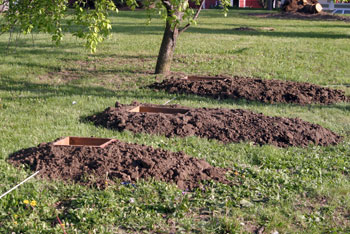One Wabash College art student is taking his creativity far outside the conventional studio or gallery.
Nic Bitting, who just finished his junior year, started experimenting with environmental and installation art during the spring semester. Notable examples of this include Andy Goldsworthy’s nature-based sculpturing and Christo and Jeanne-Claude’s "Gates" exhibit that briefly took over New York’s Central Park in February 2005.
 Bitting’s second attempt at the medium was titled "The Caleb Mills Cemetery: A Self-Guided Tour." When he decided to do another onsite project, he started looking for a subject. Bitting searched Wabash’s archives and consulted the college’s archivist, Elizabeth Swift, for some interesting history. She told him about a graveyard where those instrumental in establishing Wabash College were once buried. Others Bitting questioned knew nothing about it.
Bitting’s second attempt at the medium was titled "The Caleb Mills Cemetery: A Self-Guided Tour." When he decided to do another onsite project, he started looking for a subject. Bitting searched Wabash’s archives and consulted the college’s archivist, Elizabeth Swift, for some interesting history. She told him about a graveyard where those instrumental in establishing Wabash College were once buried. Others Bitting questioned knew nothing about it.
"I thought it would be a great idea to tell others the story using visuals," said Bitting, who’s from Carmel.
The graveyard once occupied the northwest corner of campus, in what is now a combination of private land and part of the parking lot behind Trippet Hall (the grave sites were moved to Oak Hill Cemetery). To achieve his concept, Bitting had to get permission from the landowners to put his exhibit on their property.
Bitting started work on the evening of April 27 and worked all night into the 28th. The finished project featured six rectangular mounds of dirt signifying graves. Each mound had a box on top with an item placed inside that represented the person buried there. One had baby shoes, representing Edward Thomson, who was just 3 years old when he died in 1839. The son of John Steele Thomson, a founder of the college and a math professor, Edward was the first buried in the Caleb Mills Cemetery.
Others included Andrew Thomson, Edward’s uncle and a bookkeeper; the Rev. James Thomson, most credited with founding Wabash College; Elihu Baldwin and Charles White, the first and second presidents of the college, respectively; and of course Caleb Mills, who died in 1879 and was Wabash’s first professor.
An onsite dispenser contained pamphlets explaining the exhibit. Visitors used a rope to correctly follow its order.
Bitting’s installation only stood for about one day. He didn’t want to take advantage of the property owners’ graciousness, and he needed to clean it up before leaving town for the weekend.
"I didn’t get the numbers I wanted," Bitting said. "But it was located in a fairly inaccessible area. I know the construction (on his nearby Phi Kappa Psi fraternity house) kept some away. Plus it was only up for a day, which doesn’t give it much of a life. But those who saw it were impressed. They were surprised with the information presented. They weren’t aware of the story I was telling."
So far he finds this type of artwork stimulating.
"I felt I needed to create art that people can have a dialogue with, something I can put somewhere nontraditional that takes people by surprise," Bitting said. "I find that very powerful.
"I still have a lot of learning to do in this style, but I feel my first two attempts were pretty successful."
 Coggeshall is a reporter for the Crawfordsville Journal Review.
Coggeshall is a reporter for the Crawfordsville Journal Review.